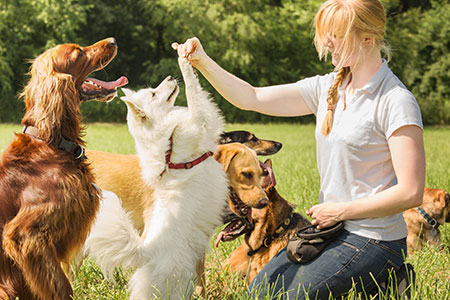A good dog trainer can be identified by their willingness to answer questions, share information, train with their own well-trained dogs, and use methods they have developed. They also see you and your dog as individuals and have a high client retention rate.
These signs indicate competence, expertise, and a genuine passion for training dogs.

Credit: www.getassist.com
1. Credentials And Certifications
When it comes to finding a good dog trainer, one of the first signs to look for is their credentials and certifications. This shows that the trainer has undergone the necessary training and education to effectively train dogs. Let’s take a closer look at the subheadings under this category.
1.1 Relevant Certifications Or Credentials
A reputable dog trainer will have relevant certifications or credentials that demonstrate their expertise in the field. These certifications can include:
- CPDT-KA (Certified Professional Dog Trainer-Knowledge Assessed)
- CCPDT (Certification Council for Professional Dog Trainers)
- APDT (Association of Professional Dog Trainers)
- IAABC (International Association of Animal Behavior Consultants)
These certifications ensure that the trainer has successfully completed training programs and has demonstrated their knowledge and skills in dog training.
1.2 Training Qualifications
In addition to certifications, it’s important to look for trainers who have specific training qualifications. These qualifications can include:
- Graduation from a reputable dog training academy or school
- Attendance at seminars and workshops on dog training
- Participation in continuing education programs to stay up-to-date with the latest training techniques
These training qualifications show that the trainer is committed to their professional development and is constantly seeking to improve their skills and knowledge in dog training.
2. Effective Training Methods
When it comes to finding a good dog trainer, one of the most important factors to consider is their training methods. A trainer who uses effective training methods sets the foundation for successful dog training. Here are two crucial signs to look out for when evaluating a dog trainer’s methods: positive reinforcement and understanding operant conditioning theory.
2.1 Use Of Positive Reinforcement
Positive reinforcement is a powerful tool in dog training. It involves rewarding desired behaviors to encourage their repetition. A good dog trainer understands the importance of positive reinforcement and incorporates it into their training methods. By using rewards such as treats, toys, or verbal praise, they create a positive learning environment for your furry friend.
Using positive reinforcement not only motivates your dog to comply with commands but also strengthens the bond between you and your four-legged companion. This method focuses on rewarding good behavior rather than punishing unwanted behaviors, making the training experience enjoyable for your pup.
2.2 Understanding Operant Conditioning Theory
Operant conditioning theory is the cornerstone of modern dog training. It consists of four quadrants: positive reinforcement, positive punishment, negative reinforcement, and negative punishment. A good dog trainer possesses a deep understanding of operant conditioning theory and applies it effectively during training sessions.
| Quadrant | Description |
|---|---|
| Positive Reinforcement | Adding a reward to reinforce desired behaviors |
| Positive Punishment | Adding an aversive consequence to discourage unwanted behaviors |
| Negative Reinforcement | Removing an aversive stimulus to reinforce desired behaviors |
| Negative Punishment | Removing a reward to discourage unwanted behaviors |
By utilizing the appropriate quadrant according to your dog’s behavior, a skilled trainer can effectively teach your pup obedience, while simultaneously avoiding harsh methods that may cause fear or anxiety. Understanding operant conditioning theory allows the trainer to tailor their approach to your dog’s individual needs, maximizing the success of the training.
When searching for a good dog trainer, keep an eye out for these signs: the use of positive reinforcement and a solid grasp of operant conditioning theory. By choosing a trainer who implements these effective training methods, you can ensure a positive and successful training experience for both you and your canine companion.
3. Personalized Approach
A good dog trainer understands that every dog is unique and requires an individualized approach to training. They take the time to tailor training plans to suit each dog’s specific needs.
3.1 Tailored Training Plans
A skilled trainer will create tailored training plans that address the specific challenges and goals of each dog and their owner. They don’t believe in a one-size-fits-all approach, as they understand that what works for one dog may not necessarily work for another.
These training plans are carefully designed to address behavioral issues and teach basic obedience commands. They take into consideration the dog’s breed, temperament, and any underlying factors that may influence their behavior.
Bold trainers will also take into account the owner’s preferences and lifestyle, ensuring that the training methods align with their expectations. This personalized approach ensures that the training is effective and enjoyable for both the dog and their owner.
3.2 Individualized Attention To Dogs And Owners
A good dog trainer recognizes that both the dogs and their owners require individualized attention to achieve the desired results. They invest time and effort into getting to know each dog and their unique personality and needs.
By understanding the dog’s individual strengths and weaknesses, the trainer can tailor their training approach to maximize results. This includes using positive reinforcement techniques that are most effective for each dog, while avoiding methods that may cause stress or anxiety.
Furthermore, a reputable trainer values clear communication with the dog’s owner, ensuring they understand the training techniques and can continue the training at home. They provide guidance and support, offering personalized advice and addressing any questions or concerns the owner may have.
This individualized attention to both dogs and owners establishes a strong foundation for successful training and creates a positive and trusting relationship between the trainer, the dog, and the owner.

Credit: www.facebook.com
4. Recommendations And Retention
A good dog trainer can be identified through several signs. They welcome questions, share information freely, have well-trained dogs of their own, train with their own developed methods, see you and your dog as individuals, and have a high client retention rate.
When it comes to finding a good dog trainer, recommendations and retention are two crucial indicators of competence and client satisfaction. Positive reviews and word-of-mouth recommendations demonstrate that a trainer has delivered exceptional results and customer service. On the other hand, a high client retention rate signifies that clients are not only satisfied with the training provided but also trust and value the trainer’s expertise.
4.1 Positive Reviews And Word-of-mouth Recommendations
Positive reviews and word-of-mouth recommendations are powerful testimonies to the effectiveness and quality of a dog trainer’s services. When past clients take the time to share their positive experiences, it shows that the trainer has successfully addressed their needs and helped them achieve their training goals. These recommendations can come from various sources like online review platforms, social media, or personal referrals.
In addition to looking for high overall ratings, pay attention to specific mention of a trainer’s expertise, professionalism, and ability to connect with both dogs and their owners. Look for trends in the reviews, such as common themes or areas in which the trainer excels. Keep in mind that even the best trainers may have a few negative reviews, so consider the overall sentiment and the trainer’s response to any concerns raised.
4.2 High Client Retention Rate
A high client retention rate is a strong indication that a dog trainer consistently delivers outstanding results and builds lasting relationships with their clients. It shows that clients are not only satisfied with the initial training they receive but also choose to continue working with the trainer for their ongoing needs.
One way to determine a trainer’s client retention rate is by directly asking for information during the initial consultation or interview process. A reputable trainer will be transparent about their retention rate and may even provide references from long-term clients. Additionally, consider asking the trainer about their approach to handling client concerns and follow-up support after the training program ends.
Remember that while recommendations and retention are crucial factors to consider when choosing a dog trainer, they should be evaluated alongside other important criteria, such as certifications, training methods, and experience. By taking a holistic approach to your decision-making process, you can ensure that you find a skilled and reliable trainer who will provide the best care for your furry friend.
5. Transparency And Communication
When it comes to choosing a dog trainer, transparency and communication are crucial factors to consider. A good dog trainer will not only have excellent training skills but also prioritize open and honest communication with their clients. Here are two key signs that indicate a trainer’s commitment to transparency and communication:
5.1 Willingness To Answer Questions
A good dog trainer will welcome questions from their clients. They understand that dog owners may have concerns or uncertainties and are more than willing to address them. If a trainer is open to answering questions and providing explanations, it shows their dedication to ensuring that clients fully understand the training process. This kind of transparency builds trust and confidence between the trainer and the dog owner.
5.2 Open Sharing Of Information
In addition to answering questions, a good dog trainer will openly share information with their clients. They are willing to provide valuable insights, tips, and advice that can help owners better understand their dog’s behavior and training progress. This open sharing of information demonstrates the trainer’s commitment to empowering dog owners with knowledge, which is essential for effective training and long-term success.
A transparent and communicative dog trainer not only educates their clients but also ensures that they feel involved and informed throughout the training process. This level of transparency fosters a strong relationship between the trainer, the dog, and the owner, leading to better results and a positive training experience overall.

Credit: www.newsweek.com
Frequently Asked Questions For 4 Signs Of A Good Dog Trainer
How Do I Know If A Dog Trainer Is Good?
To determine if a dog trainer is good, ask if they have certifications and what training equipment they use. Inquire about their approach to stopping unwanted behavior and working with anxious dogs. Also, find out about their commitment to continuing education and ask if you can observe a class.
How Do You Tell If Your Dog Is Well Trained?
A well-trained dog exhibits certain characteristics. Look for signs such as good response to commands, appropriate behavior in different situations, calm demeanor, and positive interactions with people and other animals.
What Are The Four Elements Of Learning Dog Training?
The four elements of learning dog training are acquisition, correction, generalization, and maintenance. These elements focus on teaching dogs new behaviors, correcting unwanted behaviors, ensuring the learned behaviors are applied in various situations, and maintaining the training over time. It is important for dog trainers to prioritize these elements for effective training.
What Are The Four Quadrants Of A Balanced Dog Trainer?
A balanced dog trainer utilizes positive reinforcement, positive punishment, negative reinforcement, and negative punishment to train dogs effectively.
Conclusion
A good dog trainer can be identified by several key signs. First, they welcome questions and freely share information without hesitation. They also have well-trained dogs of their own, showcasing their expertise in the field. Additionally, these trainers have developed their own methods and approaches, tailored to each individual dog and owner.
A good dog trainer sees both the owner and the dog as unique individuals and works towards building a strong relationship between them. Finally, high client retention is a clear indicator of a successful and effective trainer. Look for these signs when selecting a dog trainer to ensure the best quality training for your furry friend.







